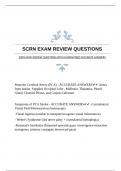SCRN EXAM REVIEW QUESTIONS
SCRN EXAM REVIEW QUESTIONS WITH GUARANTEED ACCURATE ANSWERS
Posterior Cerebral Artery (PCA) - ACCURATE ANSWERS✔✔ Arises
from basilar. Supplies Occipital Lobe , Midbrain, Thalamus, Pineal
Gland, Choroid Plexus, and Corpus Callosum
Symptoms of PCA Stroke - ACCURATE ANSWERS✔✔ -Contralateral
Visual Field Homonymous hemianopia
-Visual Agnosia (unable to interpret/recognize visual information)
- Weber's Syndrome (3rd nerve palsy + contralateral hemiplegia)
-Parinaud's Syndrome (Impaired upwards gaze, convergence-retraction
nystagmus, primary conjugate downward gaze)
,Anterior Inferior Cerebellar Artery (AICA) - ACCURATE
ANSWERS✔✔ Feeds anterior inferior parts of the cerebellum
Symptoms of AICA Stroke - ACCURATE ANSWERS✔✔ Lateral
Pontine Syndrome: vertigo, vomiting, nystagmus, falling towards the
side of the lesion, ipsilateral loss of sensation to the face, ipsilateral
facial paralysis, ipsilateral hearing loss
Posterior Inferior Cerebellar Artery (PICA) - ACCURATE
ANSWERS✔✔ Feeds cerebellum, superior section of the medulla,.
Choroid plexus and fourth ventricle
Symptoms of PICA Stroke - ACCURATE ANSWERS✔✔ Wallenburg
Syndrome (lateral Medullary Syndrome): Loss of pain and temperature
sensation in the contralateral trunk and ipsilateral face
Basilar Artery - ACCURATE ANSWERS✔✔ An artery, formed by the
fusion of the vertebral arteries, that supplies blood to the brainstem
(medulla and pons) and to the posterior cerebral arteries.
Symptoms of Basilar Artery Stoke - ACCURATE ANSWERS✔✔
Coma, quadriparesis, ataxia, dysarthria, CN dysfunction and visual
deficits, Locked in Syndrome, Intranuclear Opthalmoplegia, gaze
paresis, Millard Gulber Syndrome CN VI VII damage (diplopia facial
weakness, loss of corneal reflex), Nausea, vomiting, diplopia, gaze
palsy, dysarthria,. vertigo, tinnitus, hemiparesis, and quadriplegia.
,Anterior Cerebral Artery (ACA) - ACCURATE ANSWERS✔✔ Feeds
the media portion of the frontal and parietal lobes as well as the corpus
callosum
Symptoms of ACA Stroke - ACCURATE ANSWERS✔✔ Contralateral
motor/sensory deficits impacting legs > arms
Middle Cerebral Artery (MCA) - ACCURATE ANSWERS✔✔ Feeds
majority of the frontal, parietal, and temporal lobes, basal ganglia,
internal capsule. It is divided M1 - M4
Symptoms of MCA Stroke - ACCURATE ANSWERS✔✔ -Aphasia if
dominant hemisphere
-Neglect if non-dominant hemisphere
-Contralateral motor/sensory loss of face/arm/leg with Arms > Legs
-Anosognosia: neglect or lack of self awareness
Venous Vascular Anatomy - ACCURATE ANSWERS✔✔ Venous
channels enter into venous sinuses located in the Dura matter.
Superior Sagittal Sinus - ACCURATE ANSWERS✔✔ Travels
posteriorly between the cerebral hemispheres towards the occiput
Straight Sinus - ACCURATE ANSWERS✔✔ Travels along the
tentorium, draining blood from the superior cerebellar veins.
, Transverse Sinus - ACCURATE ANSWERS✔✔ Travels along the base
of the occiput laterally and forwardly
Sigmoid Sinus - ACCURATE ANSWERS✔✔ Begins beneath the
temporal bone and travels to the jugular foramen where it becomes the
internal jugular veins
Stroke Pathophysiology - ACCURATE ANSWERS✔✔ Arterial blood
flow to the brain tissue fails to meet metabolic demands resulting in cell
damage or death. ISCHEMIA FIRST THEN INFARCT.
Penumbra - ACCURATE ANSWERS✔✔ Zone surrounding the core
infarct, damaged by ischemia but not yet infarcted
---- functionally silent yet metabolically active
Hypoxia leading to Necrotic Pathway - ACCURATE ANSWERS✔✔
Cell energy failure
Hypoxia leading to Apoptotic Pathway - ACCURATE ANSWERS✔✔
Programmed cell death in the penumbral zone
ICH Stroke Pathophysiology - ACCURATE ANSWERS✔✔ Occurs
when a cerebral blood vessel opens abnormally and spills blood into
brain tissue.




